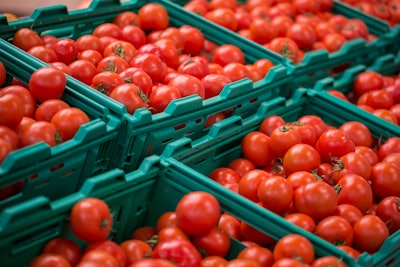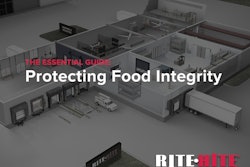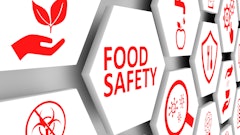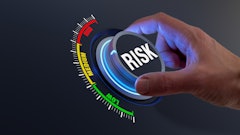
Whether we realize it or not, supply chains—local and global—enable our society to prosper. The cars we drive. The electronics that consume us. And, of course, the food we eat. However, supply chains don’t operate among us without risk. While parts may be delayed for a new vehicle or a shortage of smartphone displays may occur, it’s the food supply chain that poses the greatest risk to our health.
The World Health Organization reports that globally an estimated 600 million people fall ill after eating contaminated food, and 420,000 die every year. With such catastrophic statistics, it’s imperative that controls are in place to mitigate supply chain risks throughout channels where food is grown, processed, distributed and ultimately consumed.
What makes risk mitigation challenging is the sheer complexity of food supply chains and the factors that impact them.
Log in to view the full article
Whether we realize it or not, supply chains—local and global—enable our society to prosper. The cars we drive. The electronics that consume us. And, of course, the food we eat. However, supply chains don’t operate among us without risk. While parts may be delayed for a new vehicle or a shortage of smartphone displays may occur, it’s the food supply chain that poses the greatest risk to our health.
The World Health Organization reports that globally an estimated 600 million people fall ill after eating contaminated food, and 420,000 die every year. With such catastrophic statistics, it’s imperative that controls are in place to mitigate supply chain risks throughout channels where food is grown, processed, distributed and ultimately consumed.
What makes risk mitigation challenging is the sheer complexity of food supply chains and the factors that impact them.
Influencers of Food Safety Risk
Complications within food supply chains can come in different forms. Jim Neale, partner for McGuireWoods, says due to customer demand and preferences, food supply chains are getting longer. Regardless of season, customers can find any fruit or vegetable in the grocery aisle or delivered to their door.
“Supply chain managers are now able to deliver food we want, when we want it and where we need it, regardless of distance. And that’s a modern marvel to have that capability,” says Neale. “However, it means we’re purchasing produce and meat and packaged goods in the supermarket that have traveled across oceans. Inevitably, as the supply chain grows, the possibility of a weak link increases.”
Angela Fernandez, vice president of retail grocery/foodservice for GS1 US, agrees, and says to have blueberries in December, such produce is likely to go through more processing and transportation. Thus, it’s an important reason to have food traceability based on global standards.
“If we can trace a product faster through increased automation and through more efficient trading partner collaboration, we will know within seconds instead of days where a product was and how to isolate any potentially contaminated product,” says Fernandez.
She adds that consumers have been demanding more information about food so they can research it online. And that knowledge goes beyond learning about allergens or food safety events such as recalls and withdrawals—consumers want to know that the products they buy align with their values and lifestyles.
“It is now up to brands, retailers and restaurant operators to make that information available in a clear, consistent and accurate format, or these companies risk becoming labeled as out of touch with their consumer base,” explains Fernandez.
 GS1 US works with several stakeholders through the following industry initiatives: The Foodservice GS1 US Standards Initiative, the GS1 US Retail Grocery Initiative and the Produce Traceability Initiative.
GS1 US works with several stakeholders through the following industry initiatives: The Foodservice GS1 US Standards Initiative, the GS1 US Retail Grocery Initiative and the Produce Traceability Initiative.
Meeting consumer values and lifestyles, however, contributes to the risks inherent in the food supply chain, says Neale. There’s pressure to source locally and buy fresh, while doing it sustainably. Thus, supermarkets are featuring imported shrimp from Vietnam in the same aisle as the heirloom tomatoes they extoll as coming from the farmer’s market down the road.
“Rather than having one large facility in the Salinas Valley supplying tomatoes for Safeway, it may have 100 or even 1,000 smaller farms supporting the chain,” says Neale. “Consumers want that diversity, and supermarkets work hard to satisfy those expectations. However, verifying food safety activities and agricultural practices on 1,000 small farms is infinitely greater than it is on one large one. Is it worth the risk?”
To mitigate risks and ensure compliant practices regulations, standards and certifications exist within the food industry. In the case of regulations, such as the Food and Drug Administration’s (FDA) Food Safety Modernization Act (FSMA), these are required procedures to operate within the food supply chain. Complementing regulatory compliance is the adoption of standards and certifications for greater oversight and controls.
The following explores how companies are using the FSMA, GS1 Standards and NSF Certification to maintain safe and efficient food supply chains.
Food Safety Modernization Act
Since being signed into law in 2011, FSMA has changed how food is regulated in the United States—from the growers and processors to the distributors and beyond. Neale of McGuireWoods says what FSMA led to was a deputization of industry to ensure food safety compliance. It shifted the legal and compliance responsibilities beyond the manufacturer to critical points throughout the supply chain.
And while initial efforts to comply were simple certificates of analysis from suppliers acknowledging compliance with FSMA’s Preventative Controls rule, it’s now evolved to actual inspections of supplier facilities to verify compliance.
“We’ve moved past those bland compliance statements toward a better understanding of what the rules really require,” says Neale. “If you’re a receiver of a product, rather than relying on the FDA and its limited resources to inspect the supplier, the FDA is now requiring you to do it. And consumers are requiring it as well.”
The result of those expectations has led to a widening scope of responsibilities beyond what was first expected in 2011. Neale describes a client who is a distributor working with 7,000 vendors and 200,000 SKUs. How does this client comply with the Preventative Controls rule where due diligence is required on thousands of vendors and even more individual products?
“When you look at the rule, inspecting each of those operations is an almost impossible task,” says Neale. “There’s no one-size-fits-all solution. What is required is an operation-specific and product-by-product analysis to determine the level of verification and inspection that is required. People want a one page, bullet-point list that demonstrates compliance with FSMA, and there are very few operations simplistic enough where that will suffice.”
Steve Stomel, CEO of ProCat Distribution Technologies, sees the same concerns and believes FSMA regulations are overreaching, which is contributing to compliance issues for food companies. A FSMA requirement is implementing food safety plans for every product. This can be an onerous task for many food manufacturers and distributors that produce and handle thousands of food items.
He says the average distribution center has 10,000 SKUs that pass through it, and every item must be evaluated for a food safety plan. Does the item include allergens? Where is the item being stored? Is there risk for cross-contamination? Is it temperature sensitive? What needs to occur if there’s a breakage? These are all critical questions that distributors must answer to mitigate food safety issues. ProCat’s software can aid in answering some of those questions by focusing on activities occurring in a distribution center, such as receiving, order picking, put away and truck loading, says Stomel.
“They’re enhanced to capture product temperature as items move through the distribution center, tracking lot numbers and expiration dates for testing upon receiving and picking,” he explains. “Most of the data that’s required for FSMA compliance can be input into a GS1 barcode. The software scans the barcode and automatically extracts all the manufacturer data and characteristics of an individual case to maintain a FSMA-compliant operation. There’s a significant amount of data captured for every product moving through a distribution center.”
Stomel adds that the technology also prevents items under or subject to a recall from entering a distribution center. A real-time list of recalled products flags those items from being received or shipped to the customer—preventing exposure and possible contamination inside the distribution center.
While technology solutions have become a critical component of meeting FSMA compliance, Neale also says people must be willing to walk the facility floor, learn where each product or ingredient is coming from, understand the supplier and its operation—because responsibilities for the product don’t end once it leaves a facility. FSMA placed the legal and compliance responsibilities on the supply chain, not simply the manufacturer.
“The Preventative Controls rule, for example, requires knowledge of products being handled to identify any potential hazards,” says Neale. “If the product is cookie dough, is the flour raw or heat treated? Knowing the risks associated with both is essential. Is the supplier heat treating the flour or is that done at your facility or by the customer who bakes the cookie dough? That knowledge serves as a preventative control and should control any pathogenic hazard.
“A preventative control requires a painstaking process where you’re mapping out ingredients, where they come from and what processes are controlled by those suppliers,” Neale adds. “Relying on third parties such as NSF International or SQF Institute is another means to ensure those preventative controls are in place with an annual audit.”
NSF International
With the sheer number of vendors and products in a food supply chain, companies are calling upon third parties to assist with their most critical supply partners. Often, the risks are too great not to invest in certification that assures independent verification of products and processes. NSF International provides public health standards and certification programs to help protect the world’s food, water, consumer products and environment.
Josh Brugeman, business unit manager, sustainability for NSF International, says understanding and establishing relationships with your supply chain, regardless of whether a program is focused on food safety, sustainability or quality (or all three) is paramount. Too often, companies don’t have a full understanding or visibility into their supply chain beyond the first tier—presenting substantial risk. Consider a major fast-food chain that’s unaware of the farms supplying lettuce and tomatoes to its locations. Not only is this catastrophic in the event of a recall and the ability to quickly trace the contaminated product, but also the potential damage to brand reputation in the aftermath.
“By having a supplier or certification program in place, you will establish better contact with your suppliers, gain a solid understanding of your network and establish consistent requirements—creating a more proactive approach to managing your business,” says Brugeman. “It is helpful for companies to first understand their risks—certain commodities, suppliers or products—to effectively develop a risk mitigation plan. Prior to moving forward with any type of certification program, it’s helpful to engage in an initial risk analysis exercise.”
According to Carey Allen, associate managing director of supply chain food safety operations at NSF International, the NSF certification process is specific to the product, process or service being certified and the type of certification, and generally follows seven steps:
- Application and information submission
- Product evaluation
- Product testing in lab
- Manufacturing facility inspection, production confirmation and product sampling
- Test results review and acceptance
- Contract signed and products listed
- Annual plant inspection and retesting
Most certifications have a rigorous set of requirements, and the audit and certification is carried out by accredited third-party organizations such as NSF International, says Brugeman. Certification provides independent verification that a product or process complies with specific international standards and enables a food supplier to give assurances that food has been produced, prepared and handled according to the most recognized standards.
“Certifications also provide brands with product differentiation and added brand value, demonstrating a commitment to quality processes and continual improvement as well as enabling access to top retailers,” explains Brugeman.
GS1 Standards
Whether it’s a certified process or a preventative control, traceability is a major objective. And food traceability would not be where it is today without GS1 standards. According to GS1 US, a not-for-profit information standards organization, businesses, trade associations, industry groups and regulatory agencies are collaborating to drive consumer confidence in food safety and commit to improved food traceability. GS1 US works with all of these stakeholders through the following industry initiatives: The Foodservice GS1 US Standards Initiative, the GS1 US Retail Grocery Initiative, and the Produce Traceability Initiative.
Together, more than 200 leading companies are committed to collaboration to improve supply chain efficiency and enhance food safety. Fernandez says the greatest threat to the food supply chain is not having any ability to control it. In terms of risk mitigation, an automated food traceability program can help a food company manage a more globally complex supply chain, become more vigilant and more recall ready.
“The basic building block of traceability is globally unique identification of each brand owner’s product,” says Fernandez. “The identification numbers are encoded into GS1 barcodes that enable the automatic data capture of this and other critical traceability information, including batch/lot numbers and expiration dates.
“When trading partners communicate in this uniform manner, supply chain systems operate more harmoniously. The internal data and processes a company uses to track products is integrated into a larger system of external data exchange that takes place between trading partners, serving as a singular approach for all to maintain and share product information,” adds Fernandez.
Adopting GS1 standards provides a system and structure to address threats to supply chain safety, she says. The following are three key GS1 standards that comprise a successful traceability program—all of which serve to mitigate risk.
- Global Trade Item Number (GTIN). This globally unique identifier of products can be recognized in all trading partner systems, even across geographic boundaries. It is encoded into a product’s U.P.C. barcode and is often referred to in news coverage of recalls along with expiration dates to specify exactly which products consumers should avoid.
- Global Location Number (GLN). A globally unique identification number for supply chain partner locations such as a farm, manufacturing plant, a distributor’s loading dock, or a restaurant or supermarket location. This number helps a company record each stop a product has made in the supply chain.
- GS1-128 barcodes. When applied at the case level, these barcodes enable companies to encode product identifiers as well as additional information such as batch/lot/serial numbers, best-by dates, variable weight information and more—key details that help companies isolate affected product during a recall.
 An example of a case label containing key traceability information. This is a format typically used for poultry in the North American grocery industry.
An example of a case label containing key traceability information. This is a format typically used for poultry in the North American grocery industry.
Lucelena Angarita, director, supply chain traceability at the franchisee-owned Independent Purchasing Cooperative (IPC) for Subway restaurants, where she is leading the adoption of GS1 Standards for the SUBWAY® system, says Subway and IPC have incorporated GS1 Standards in all its contracts since 2014, with every supply chain partner. The ultimate goal is to know the lot/production date of every product case within seconds.
She says the food industry needs to improve within a few critical areas.
- First, there is a lack of standardization. Using the same terminology and having clear understanding and alignment is critical in reducing the chances of complications and potential issues.
- Second, technology is playing a larger role in businesses and people’s daily lives. Supply chain traceability is an area where technology can help decrease the probability of human error.
- Third, the lack of consistent records and barcoding that would contain uniform, full information to aid traceability is an opportunity to enhance the food supply chain.
As a global brand with hundreds of supply chain partners in North America, Angarita says a detailed system assigns unique global identifiers to products (GTINs), locations (GLNs) and GS1 barcodes for traceability (including GTIN, date, lot). Subway also requires partners to share information electronically (not via email or fax) in a standard language.
“We’ve standardized our system so that we have consistent records shared in a uniform manner,” says Angarita. “This system incorporates synchronizing product information in the GDSN (GS1 Global Registry) for a single source of truth and unified data governance—and, we have seen success.
“Today, 99 percent of our partners are using this system, 94 percent of our food and packaging suppliers have traceable barcodes on their Subway-branded product cases, and 28 percent of our distribution system is currently scanning the unique GS1-128 barcode when they deliver cases to our restaurants. We anticipate 50 percent of our distribution system will be scanning cases in the next six months,” adds Angarita.
What is next for supply chain traceability? Angarita believes the food industry is on the cusp of a major change, in part to supply chains incorporating modern standards like GS1 into their operations. Traceability has evolved from being a competitive advantage to a responsible imperative, where a full, detailed understanding of product history is transparent to the public.
“Technology plays an essential role in traceability, but it’s a tool that weaves pieces together. It alone cannot improve internal processes if we don’t have the right data flowing through them,” explains Angarita. “However, the GS1 standards can. These standards provide the foundation so we can apply technology and achieve full supply chain traceability and transparency, which is what our customers expect and demand every day.”
Next Stage of Risk Mitigation
As regulations and standards evolve, what is the next phase in risk mitigation? Much of it is data focused. By leveraging standardized product information and data-sharing protocols, capturing more data through automation and synchronizing it with trading partners, companies have more accurate and consistent information available to them in real time, says Fernandez.
“Now is the time to prepare for the future by instituting business best practices around data with a focus on the foundational components of using GTINs for standardized identification of products,” she says. “Many have started cleaning their data by working through the GS1 US National Data Quality Program. It provides a framework for data governance, outlines auditing procedures, and facilitates cross-functional education on data quality. This also helps a company deliver the product information transparency that consumers crave today.”


















